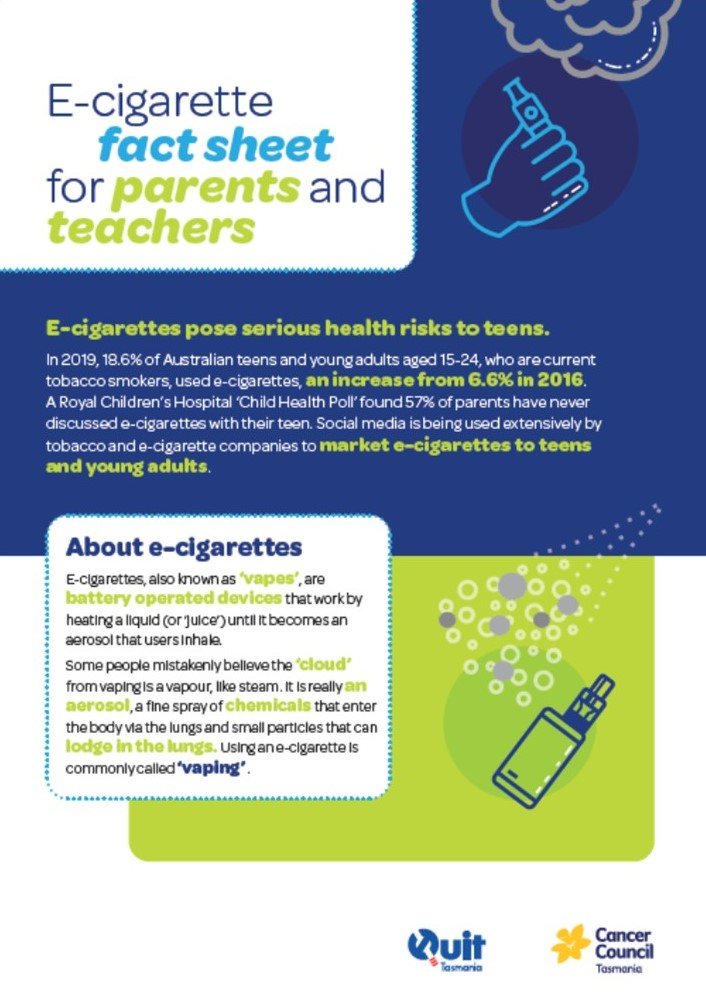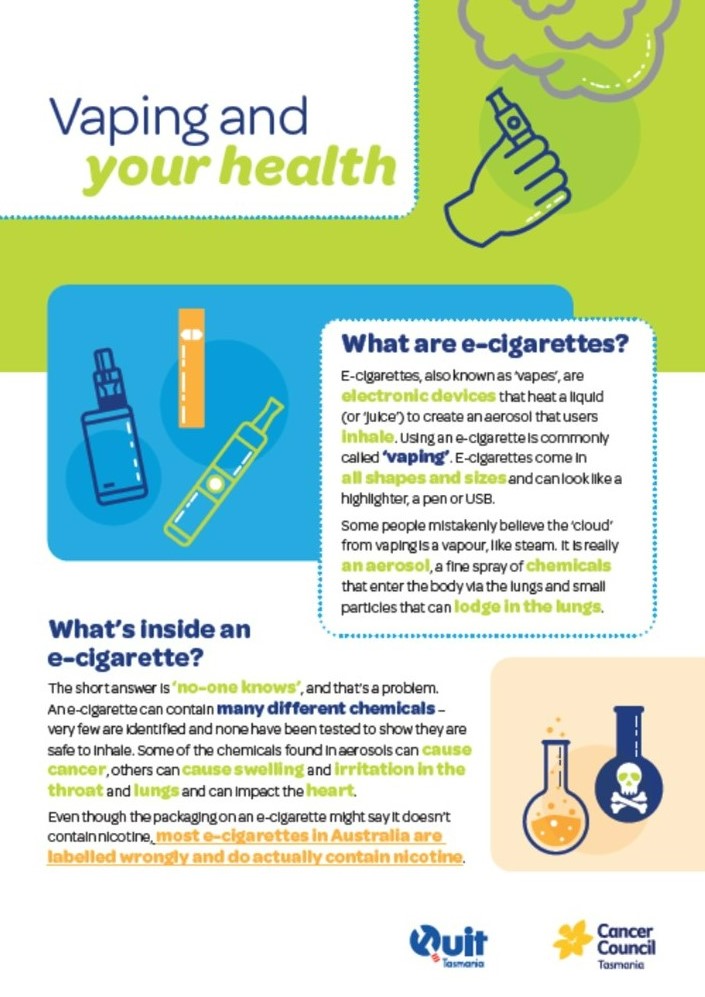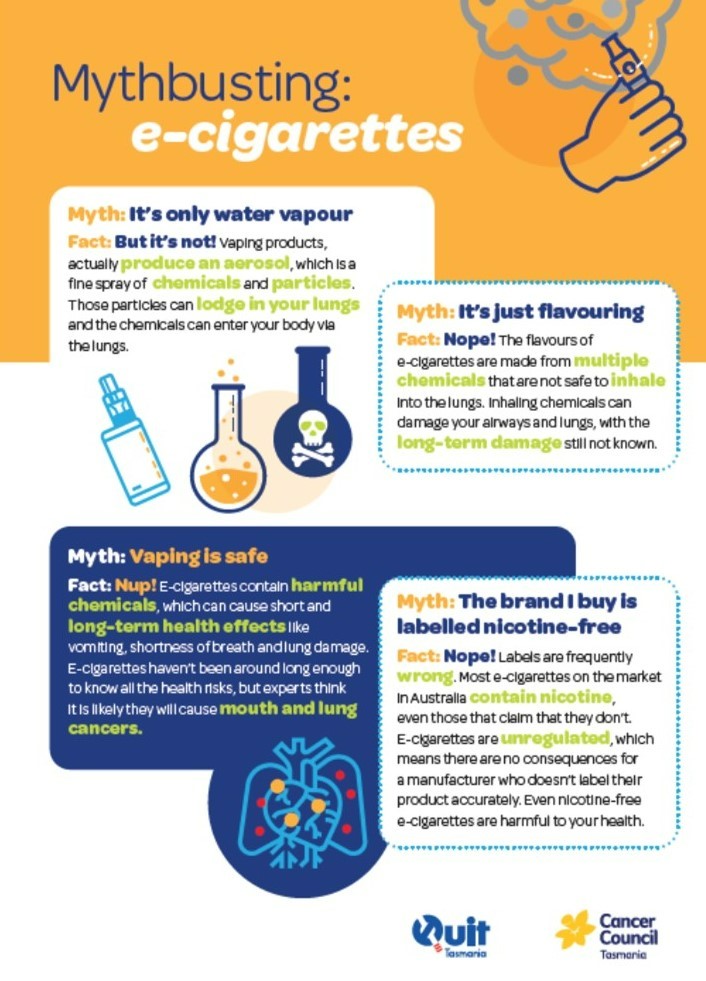E-cigarettes, also known as vapes, are battery powered devices that heat a liquid – also known as e-liquid and e-juice – until it turns into an aerosol, which the user then inhales.
They come in many shapes and sizes and can look like everyday items including highlighters, pens, USBs and makeup.
Why are young people vaping?
- Aggressive marketing by tobacco industry
- Product packaging, flavours and taste designed to be appealing
- Social media influence
- Easily accessible from retail outlets, other people and online
- Peers using e-cigarettes/vaping
E-cigarette facts
- Use of e-cigarettes is harmful to health
- E-cigarettes, like cigarettes, involve inhaling chemicals into the lungs, which means people who use them are at risk of lung injury and other negative health outcomes
- Many e-cigarettes contain nicotine, even if it is not on the label, making them very addictive
- Nicotine is harmful for young brains which are still developing until age 25. Nicotine use can harm attention, memory and learning centres in the brain
- E-cigarettes produce aerosol, not harmless water vapour. Ultrafine particles from the aerosol can lodge in the lungs.
- Can contain the same harmful chemicals found in cleaning products, nail polish remover, weed killer and bug spray
- Flavours have not been tested for safety when INHALED
Fact Sheets (click to view and download)
Do you know what you’re vaping?
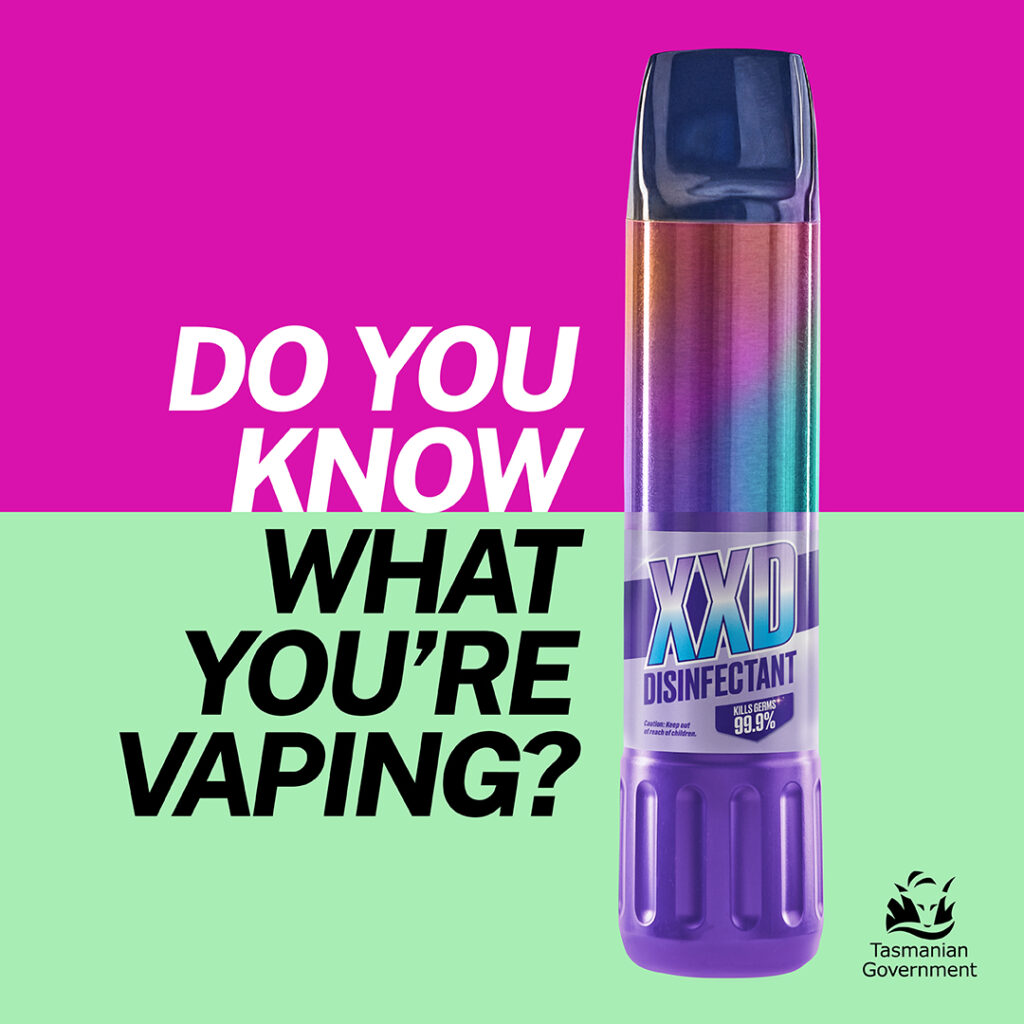
The Department of Health (Tasmania) has launched a campaign with new resources on e-cigarettes and vaping. For more information click here.
Understanding nicotine addiction
Nicotine is the addictive chemical found in cigarettes and many e-cigarettes. When a person smokes/vapes, nicotine gets to the brain quickly – within about 7-10 seconds. Nicotine affects the chemicals in the brain, including the feel-good chemical dopamine, and after a puff a person may feel good for a little while. It may make them feel relaxed or more alert, but this does not last long.
After a while, as the effects of nicotine fade, a person may feel tense or irritable, or they may find it hard to focus on what they are doing. But their next cigarette or e-cigarette relieves these feelings. These up and down mood changes over the day are common among people who smoke or vape.
Repeated use of nicotine can cause dependency; a person has a very strong desire to continue using nicotine and may have difficulty stopping.
Most e-cigarettes contain nicotine.
Nicotine is harmful for the young brain which is still developing until about age 25. Nicotine use affects brain development, especially the part responsible for attention, memory and learning.
Poster: e-cigarettes and nicotine: the facts (click image to view and download)
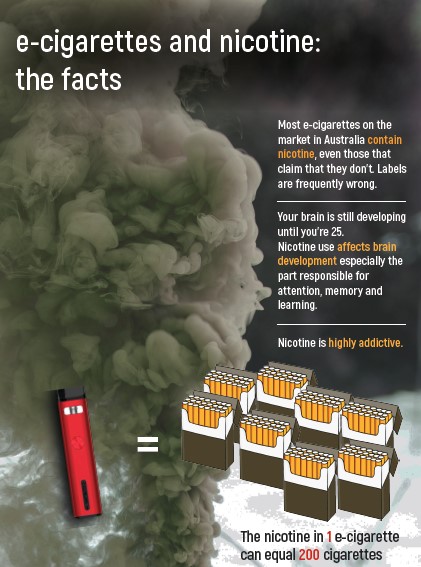
Signs of nicotine addiction in young people:
- Cravings – having strong urges to vape/smoke
- Feeling irritable when unable to vape/smoke
- Hard to concentrate when unable to vape/smoke
- Feeling nervous, restless or anxious because unable to vape/smoke
- Tried to quit, but found it difficult
Withdrawal symptoms
It is normal to experience withdrawal symptoms when it has been some time since last use of nicotine or when quitting. These withdrawal symptoms weaken and fade over time as the brain gets used to not having nicotine.
- Irritability, frustration, anger
- Anxiety
- Cravings
- Restlessness
- Difficulty in concentration
- Depressed mood
- Can have trouble sleeping
- Increased appetite
How to quit
- NRT can be helpful – patch, gum, lozenge
- Find a support person/s
- Identify the triggers – certain people, feelings, or situations – that can make a person to want to vape/smoke – and explore strategies for dealing with these triggers
- Learn how to manage withdrawal symptoms
- Call Quitline 13 7848 for helpful tips and advice
- For tips on getting through the first few weeks click here
Quitting can take a number of tries…so, never give up giving up
What can parents / caregivers do?
- Learn about e-cigarettes and the risks associated with using them
- Take the time to talk to your child/children and help them understand the risks
- Choose a time when you’re doing an activity together, so it’s a relaxed setting
- Have a two-way conversation; listen to their point of view
- Don’t be judgemental or make assumptions
- Focus on how you care about them and want them to be healthy
- If your child is vaping, encourage them to stop. Let them know that help and support is available
- Set a positive example by being tobacco and e-cigarette free
Information for those working with young people
- Provide accurate information and education – explain health risks
- Vaping and tobacco smoking information can be delivered together
- Help the young person to identify their triggers for vaping – and how to avoid them
- Discuss nicotine withdrawal symptoms and how to manage them
- Provide cessation resources
- Create a quit plan
- Refer to Quitline 13 7848 (Quitline Referral Form)
Training for service providers
Free ‘Supporting People to Stop Smoking/Vaping’ training. For more information click here
What support is available to help with quitting?
- Quitline 13 7848
- Doctor or other Health Professional
- Youth Health Services
- North: Cornerstone Youth Services
- North: Ravenswood Community Health Centre
- North West: Ulverstone Central Coast Community Health Centre
- South: The Link Youth Health Service
- South: Pulse Youth Health Services
The Law
- Smoke free areas: prohibit use of e-cigarettes/vaping and smoking tobacco
- It is illegal to give, lend, or sell e-cigarettes to anyone under 18 years old
- People under 18 years old are not allowed to buy, use, or possess e-cigarettes
- Nicotine vaping products (e-cigarettes containing nicotine) are only available with a prescription from a doctor, for people over 18 as a tool to help them quit smoking
For more information on laws about e-cigarettes in Tasmania
For more information on smoke-free areas in Tasmania
Changes to vaping law in Tasmania from 1 October 2024
The way Australians can access vapes has changed* Tasmania has passed new legislation that states:
- Adults (18+) require a doctor’s prescription to get vapes (e-cigarettes)
- The sale of vapes to people under 18 is not allowed.
- Only pharmacies can sell vapes. They require a licence to do so. Not all will obtain a licence.
- Non-pharmacy retailers, such as tobacconists, vape shops and convenience stores, or individuals cannot sell any type of vape
- Flavours in vapes are restricted to mint, menthol and tobacco
- The advertising or promotion of vapes is generally prohibited
- Anyone involved in transporting, storing or handling vapes must comply with strict requirements
Find out more:
https://www.health.tas.gov.au/vaping#tasmanian-ecigarette-vape-laws
* All Australian states adhere to the new vaping laws, however, some states like Tasmania have added additional legislation.
https://www.tga.gov.au/products/unapproved-therapeutic-goods/vaping-hub/changes-regulation-vapes
Environmental impact
- Increase in single-use plastics
- Increase in plastic pollution
- Increase in tech waste from e-cigarette parts, including lithium-ion batteries
- Introduction of toxic chemicals into the environment when discarded
- Toxic compounds from lithium batteries progressively leach into the environment as they degrade
For more information on the environmental impact of vape waste
